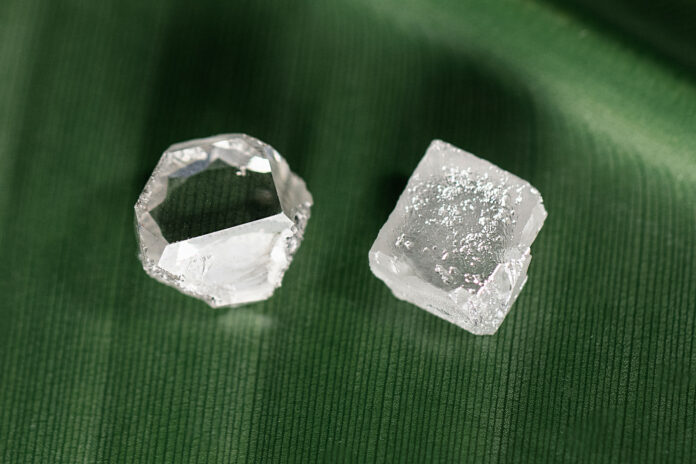In an industry where ethical practices are valued, lab grown diamonds offer an excellent alternative to traditionally mined diamonds. These gemstones, created through cutting-edge technology, offer a fascinating blend of science and artistry, resulting in breathtaking, conflict-free and ethically responsible diamond jewelry, from lab grown diamond rings to lab grown diamond bracelets.
Learn how lab grown diamonds are made, from the initial seeding to the final polishing and explore the advanced techniques used to simulate the natural conditions under which diamonds form.
The Genesis of a Diamond: The Seed Crystal
At the core of every lab created diamond lies a tiny but vital element—the seed crystal. This microscopic diamond fragment is the foundation upon which new layers of carbon atoms are carefully deposited. These seed crystals are often fragments sourced from existing, high-quality mined diamonds chosen for their clean structure and minimal impurities. However, they can also be sourced from other lab grown diamonds, depending on the manufacturer’s practices.
The selection of seed crystals is critical because they determine the final diamond shape and size and the overall quality. Seeds with ideal crystal lattice arrangements are chosen to ensure optimal symmetry and brilliance in the new diamond.
The seeds are then prepared for the growth process with chemical baths and ultrasonic cleaning methods to ensure a flawless foundation for the resulting diamond.
The Growth Journey: From Seed to Stone
Once the seed crystal is chosen, the manufacturer uses two main methods to create the final gem: High Pressure, High Temperature (HPHT) and Chemical Vapor Deposition (CVD).
- High Pressure, High Temperature (HPHT)
The HPHT process uses intense heat and pressure to mimic the natural conditions found deep within the Earth’s mantle, where natural diamonds are created.
It begins by placing a diamond seed within a specially designed cell inside a press. The environment inside the growth chamber is intensely heated to temperatures between 1300-1600 °C and subjected to pressures exceeding 870,000 psi. Within this extreme setting, a molten metal flux dissolves a high-purity carbon source like graphite.
Because the temperature is higher at the top of the press than at the bottom, carbon atoms migrate and precipitate onto the diamond seed, starting the crystallization process that results in the growth of a synthetic diamond over several weeks.
- Chemical Vapor Deposition (CVD)
The Chemical Vapor Deposition (CVD) process for creating lab grown diamonds involves a refined technique where diamond crystals develop from a hydrocarbon gas mixture under controlled conditions.
Diamond seed crystals are strategically positioned inside a vacuum chamber and the environment is filled with carbon-rich gas, such as methane. This chamber is heated to temperatures ranging between 900-1200°C. A critical part of this process involves a microwave beam, which energizes the gas to form a plasma cloud. This enables the carbon atoms to precipitate and gradually deposit onto the cooler diamond seed plates.
Unlike HPHT, this growth process is phased, requiring the diamonds to be periodically removed for surface polishing to eliminate any amorphous carbon accumulations before being returned to the chamber to continue growth. These cycles may repeat several times over three to four weeks, depending on the desired size and quality of the diamond.
Post-Growth Processing: Cutting, Polishing and Preparing
Once the lab grown diamond has reached its right size and quality level, it transforms from a rough stone to a polished and brilliantly faceted gem. This phase, known as post-growth processing, is where the true artistry of diamond craftsmanship shines.
Skilled artisans use innovative techniques and technologies to precisely cut and polish the diamond to showcase its maximum fire, brilliance and scintillation. Advanced laser cutting and computer-aided design ensure precise facet placement and angles, while specialized polishing wheels and compounds bring out the diamond’s full luster.
The Grading Process: Assessing Quality and Authenticity
Like real diamonds, lab created gems undergo a strict diamond grading process to evaluate their quality based on the internationally recognized 4Cs: cut, color, clarity and carat weight.
Major gemological laboratories, such as the International Gemological Institute (IGI) and the Gemological Institute of America (GIA), are responsible for grading and certifying these diamonds. These organizations have established rigorous standards to ensure transparency and maintain consumer trust in the market.
The grading report issued by these organizations is a valuable resource when shopping for diamond jewelry, providing detailed information about the diamond’s characteristics and authenticity. This helps you make better purchasing decisions when investing in lab grown diamond rings, bracelets or other fine jewelry pieces.
Craftsmanship Meets Science: Celebrating the Art Behind the Gem
From the selection of the seed crystal to the artistry of cutting and polishing, the journey of a lab grown diamond is a fusion of science and craftsmanship. These gemstones celebrate the beauty and brilliance that can be achieved through human ingenuity and technological advancements.
Whether you’re buying a lab grown diamond engagement ring, a wedding band or a lab grown diamond tennis bracelet, these diamonds allow you to find a gem that represents your personal style while making an ethically responsible choice. With their unparalleled quality and price point advantage, they are redefining the fine jewelry industry, making luxury and ethical beauty accessible to all.














